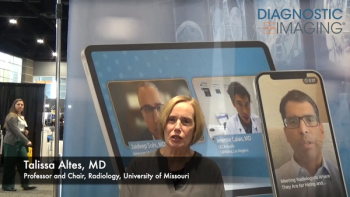
Radiologist touts pads for better MR scans
Making patients comfortable on the MR table keeps them from moving, resulting in fewer repeat sequences and fewer callbacks, according to a study presented at the 2006 RSNA meeting. Dr. Peter Rothschild, the developer of pads and pillows that made those findings possible, couldn’t be happier.
Making patients comfortable on the MR table keeps them from moving, resulting in fewer repeat sequences and fewer callbacks, according to a study presented at the 2006 RSNA meeting. Dr. Peter Rothschild, the developer of pads and pillows that made those findings possible, couldn't be happier.
Rothschild, president and founder of IES Patient Comfort Systems, came to the RSNA exhibit floor brandishing the cushions he says will produce the same results at any imaging center or radiology department. The pads and pillows bear the Tempur-Pedic name and are made from the same material that goes into beds and pillows designed to help consumers get a good night's rest.
"The Tempur material is heat-sensitive, so the longer the patient lies on it, the more comfortable it is," he said.
Repeat sequences and patient callbacks dropped substantially when MR patients lay on Tempur pads, Rothschild said, citing a study conducted at the University of Louisville School Of Medicine.
Two hundred lumbar MR exams were conducted using traditional pads. Another hundred were done using the new Patient Comfort Systems pads. When traditional pads were used, 18% of the scans required at least one sequence to be repeated, and 8% needed the entire procedure repeated because of motion artifacts. By contrast, when Patient Comfort Systems' pads were applied, only 8% required a repeat sequence, and just 4% needed repetition of the entire exam.
The researchers concluded that the pressure-managing Tempur material led to decreased patient motion, which increased throughput and decreased patient callbacks.
Rothschild developed and researched the cushions responsible for this improvement jointly with Tempur-Pedic Medical, which manufacturers the pads and pillows. Initially, the pads were developed to solve patient motion problems in Rothschild's own imaging center, Open MRI, in Hayward, CA. At the RSNA meeting, he launched a national sales campaign directed at imaging centers and radiology departments to buy the pads for their own use.
Rothschild's company, IES Patient Comfort Systems, has begun running radio ads to get patients to ask for the Tempur-based products, as the company assembles a direct sales force to sell them. Meanwhile, he is negotiating with equipment vendors to include the pads with MR scans and those of other modalities.
Rothschild is a veteran of bringing niche products to the MR market. Some 15 years ago, he helped develop software to reduce the noise found in images generated by the 0.064T Toshiba Access MR scanner at his Hayward, CA, imaging center (DI SCAN, 4/22/92,
"We are building products for my colleagues, products that make a difference in patient comfort," he said.
The Tempur-based table pads, knee wedge, and positioners conform to the body, allowing a more comfortable exam with a significant decrease in patient movement. And these are just the beginning. Rothschild came out with three other products based on similar concepts and materials at the RSNA meeting.
"The most exciting are the noise-reduction earmuffs that go in head coils," he said. "They are much cheaper than earphones, and they fit in every single coil."
The two others are a neck flexion device made of several pads (removing one after the other causes the neck to change and hold positions so each can be individually imaged) and an armrest to position the patient for shoulder exams or to keep the arm steady during intravenous injections.
Newsletter
Stay at the forefront of radiology with the Diagnostic Imaging newsletter, delivering the latest news, clinical insights, and imaging advancements for today’s radiologists.




























